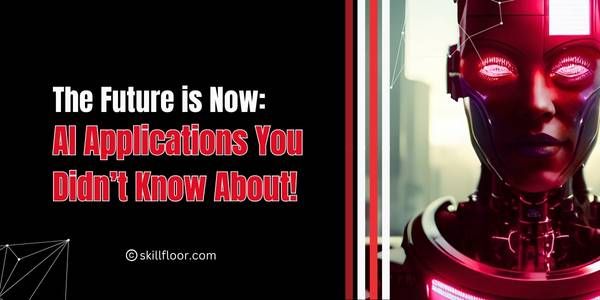Types of Artificial Intelligence
Are you struggling to understand AI? Learn the different types of artificial intelligence and how they can impact your life and work -- in simple, easy-to-grasp terms.

Have you ever wondered how Siri can understand your voice? Or how self-driving cars make decisions on the road? Well, these are examples of artificial intelligence in action. Having worked as an AI researcher for more than 5 years, I have seen the field's explosive expansion and change. The fact that artificial intelligence can be divided into many groups according to its features and capabilities is one of its most interesting characteristics. This guide will cover the various forms of artificial intelligence and explain them in an understandable manner, whether you're new to the idea or simply want to know how it all works.
Have you ever thought about...
-
How does a computer know when to recommend a new movie to you on Netflix?
-
What makes a chatbot so skilled at answering questions almost instantly?
-
Why do some AI systems seem so "intelligent" while others can only perform basic tasks?
When exploring the many forms of artificial intelligence, these are only a few questions that may strike your mind. AI enters every aspect of our lives, whether through smartphones, virtual assistants, or the most recent developments in machine learning. However, when we analyze the various forms of artificial intelligence, what do we mean exactly? We'll break it down for you in this article, explaining how AI is organized based on its features and capabilities. Let's get started!
The Different Types of Artificial Intelligence
There are two main methods used to classify artificial intelligence: by functionality and by capabilities. Both categories help in our understanding of the abilities and operation of AI systems. Let's take a closer look at each category.

1. Types of Artificial Intelligence Based on Capabilities
The level of intelligence that an AI system includes is what we mean when we talk about different forms of AI based on capabilities. Narrow AI, general AI, and superintelligent AI are the three main categories.
Narrow AI
The most common kind of AI in use today is narrow AI, sometimes known as weak AI. This type of AI works within an established set of skills and is made to carry out particular tasks. Consider your email spam filter or the recommendations that appear on your favourite shopping website. These systems are designed to address certain issues, but they lack any additional awareness.
This includes the majority of the AI systems we use on a regular basis. While they are highly skilled at some jobs, they are limited by their programming. Essentially, narrow AI is highly specialized but not adaptable.
Example: Spotify's music recommendation system. It can only do one thing, which is to recommend songs based on your listening history.
General AI
A more advanced idea that attempts to imitate human intelligence is general AI, sometimes referred to as strong AI. Any intellectual task that a human can complete, this kind of AI can do too. General AI is capable of understanding, learning, and applying information across a wide range of tasks, compared to narrow AI, which is limited to specific uses.
General artificial intelligence is currently only theoretical and has no practical uses. While general artificial intelligence is still a long way off, scientists and researchers are still working toward its development. General AI has the potential to completely change how humans work, learn, and interact with machines if it becomes a reality.
Example: A hypothetical artificial intelligence (AI) that could do every task that a human could, like cooking, driving, or solving problems in any situation (still hypothetical).
Superintelligent AI
The term "superintelligent AI" describes a form of intelligence that is completely superior to human intelligence. It is far faster and more accurate than a human in thinking, reasoning, and solving complicated issues. Even though this kind of AI sounds like something from a science fiction film, the AI community is seriously considering it.
Even some experts express concerns about the possible risks of superintelligent AI, which is yet entirely hypothetical. Still, it's amazing to consider a machine that might be more intelligent than a human in almost every way.
Example: A future AI that could perform better than humans in every way, including making decisions more quickly, solving problems more effectively, and understanding difficult topics like medical research or climate change (which isn't possible yet).
2. Types of Artificial Intelligence Based on Functionalities
AI systems can be grouped according to their functions, or how they carry out their jobs, in addition to their capabilities. Reactive machines, limited memory, theory of mind, and self-aware AI are the four primary categories of AI that fall under this category.
Reactive Machines
The most basic type of AI is used in reactive machines. These systems do not recall things or draw lessons from the past; instead, they are made to react to specific stimuli. They do not know the past and carry out jobs according to the situations at them.
IBM's Deep Blue, the chess-playing computer that beat world champion Garry Kasparov in 1997, is a prime example of a reactive machine. Deep Blue was able to make strategic moves and analyze millions of chess positions. It was unable to learn from prior experiences, however, and had a recollection of earlier games. It only responded to the game's present situation.
Would you be interested in checking out this site for more information? Refer here: https://en.wikipedia.org/wiki/Deep_Blue_(chess_computer)
Limited Memory
Insufficient memory As the term implies, artificial intelligence (AI) systems may learn from their prior experiences and gradually get better at what they do. By processing and retaining information from past events, these AI systems are able to make better decisions going forward.
One of the best examples of AI with limited memory is self-driving cars. In order to make wise decisions while driving the streets, these cars constantly collect information from their sensors about obstacles, traffic patterns, and road conditions. The system can modify its behaviour in real time based on its experiences, even though it lacks long-term memory and an extensive understanding of the environment.
Theory of Mind
The term "theory of mind" describes an advanced type of artificial intelligence that can understand feelings, beliefs, and intentions—in other words, the mental states of other living beings. This degree of AI has not yet been achieved and is currently in the development phases. But eventually, AI is supposed to be able to understand human emotions and communicate more socially and emotionally.
For example, a theory of mind AI might be employed in customer service to manage circumstances that call for empathy and understanding, or in healthcare to help patients with emotional support. Even though the technology is still in its infancy, it has enormous potential to enhance human-AI interactions.
Self-Aware AI
The most advanced and, in many ways, the least popular type of AI is self-aware AI. These systems would be conscious of their own existence in addition to their surroundings. In addition to having awareness, a self-aware AI might be able to make choices based on its own view of reality.
Self-aware AI is still only a theoretical idea at this time. Although some scientists think it might be feasible in the future, building machines with awareness and the ability to make decisions on their own raises several ethical issues. Science fiction frequently uses this kind of AI, where machines develop self-awareness and start to wonder about their role in the world.
Example: An imaginary AI similar to the 2001 HAL 9000: A space odyssey with consciousness, self-awareness, and the capacity for independent decision-making (both hypothetical and unbuilt).
You might find it interesting to check out this site.
For more information: https://airandspace.si.edu/stories/editorial/2001-space-odyssey-hal-and-future-ai
Why Understanding the Types of Artificial Intelligence is Important
Anyone who wants to stay up to date with the newest technological advances or is thinking about using AI in business or research must have a strong understanding of the many forms of artificial intelligence. We can make better decisions on how to use AI systems responsibly and ethically if we are aware of their capabilities and features.
For example, we must understand the possible hazards and limitations of various forms of AI while developing AI for healthcare or finance. Narrow AI might work well for automated jobs, but when empathy, intuition, and critical thinking are needed, advanced AI might be needed. Furthermore, it's critical to think about the social impacts of AI as it penetrates our daily lives, particularly as AI systems develop further.
Challenges and Opportunities in AI Development
|
Challenges in AI Development |
Opportunities in AI Development |
|
Bias – AI systems may make biased decisions based on data. |
Better Decisions – AI can help make smarter, data-driven decisions in many fields. |
|
Job Loss – AI might replace some jobs, especially in routine tasks. |
Increased Efficiency – AI can automate repetitive tasks, saving time and effort. |
|
Privacy Concerns – AI needs lots of personal data, raising privacy issues. |
Personalization – AI can create more personalized experiences in shopping, entertainment, etc. |
|
Complexity – AI systems can be hard to understand and manage. |
Healthcare Advancements – AI can assist doctors in diagnosing and treating patients better. |
|
Security Risks – AI could be used for harmful purposes like hacking or surveillance. |
Innovation in Daily Life – AI can improve everyday life through smart devices and services. |
|
Ethical Issues – There are concerns about how AI makes decisions, especially in sensitive areas. |
Environmental Solutions – AI can help solve global issues like climate change and resource management. |
Finally, there are two primary categories of artificial intelligence: those that are based on functionalities (such as reactive machines, restricted memory, theory of mind, and self-aware AI) and those that are based on capabilities (such as narrow, general, and superintelligent AI). Although each type has its advantages and difficulties, they all can change industries and enhance people's lives.
Understanding these kinds is essential for professionals, tech enthusiasts, and students wishing to use AI as research into the technology advances. Understanding the many kinds of AI that underpin self-driving cars and virtual assistants enables us to better appreciate the technology. AI's future lies not only in creating more intelligent machines but also in how people may use this technology to create a more effective and better world for everybody.






























































